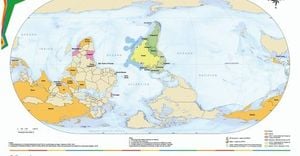On May 8, 2025, the United States and the United Kingdom reached a significant agreement regarding tariff trade terms, a move that President Trump described as a "very important and exciting day" for both nations. The announcement came through a post on Trump's social media platform, where he emphasized that the agreement would solidify the relationship between the two countries for years to come.
The trade deal, however, is not being promoted as a comprehensive free trade agreement, which typically requires extensive negotiations over several years. Instead, it focuses on specific industries, with both sides making concessions that reflect their economic priorities. A British official noted that the announcement would outline general terms, and British Prime Minister Stammer was scheduled to address the agreement later that day.
As the largest trading partner of the UK, the United States imports approximately £179 billion ($222 billion) worth of goods and services from the UK annually. In exchange for the US reducing tariffs on UK car exports, the UK government has agreed to concessions on importing American food and agricultural products. Specifically, the US has retained a 10% base tariff, which officials consider a minimum requirement for trade partners.
Concerns were raised regarding the 10% tariff, as officials explained that it was retained to prevent manufacturers from evading tariffs by altering the final assembly or packaging locations of goods. This decision comes amidst increasing dissatisfaction among the American populace regarding Trump's economic management, as several polls indicate a growing discontent.
During the announcement, Trump stated, "The trade agreement is a comprehensive and complete agreement that will solidify the relationship between the United States and the UK for many years to come." He expressed optimism about the future of trade negotiations, suggesting that more agreements would follow as he works to eliminate barriers to US exports and ease market turmoil caused by tariffs.
Despite the optimistic rhetoric, the reality of the agreement may not live up to the expectations set forth. The UK’s relationship with the US is still perceived as worse than before the initiation of the tariff war, providing potential points of criticism for Stammer’s political opponents.
In a related development, the UK government announced that tariffs on UK car exports to the US would be reduced from 27.5% to 10%, and tariffs on steel and aluminum would drop from 25% to zero. This adjustment is expected to apply to 100,000 UK cars, nearly covering the total amount of UK exports to the US in 2024.
Additionally, the agreement includes a new reciprocal access arrangement for the beef market, allowing UK farmers to obtain a tariff-free quota of 13,000 tons. The UK has also committed to reducing tariffs on US-made ethanol used for beer production to zero. However, the UK emphasized that it would not relax its standards for imported food.
In response to inquiries about whether this agreement signifies an improvement in UK-US trade relations, Prime Minister Stammer remarked, "You should ask whether it is better than the situation we had yesterday." His statement reflects the cautious optimism surrounding the deal, as both parties navigate the complexities of international trade.
As negotiations continue, they also extend to other countries, including Japan, India, and Israel. The US is seeking to establish basic agreements with these nations, but many of the details typically included in comprehensive trade agreements may still need to be negotiated in the future.
Trump's administration is currently investigating the pharmaceutical industry, and the UK is keen to avoid potential tariffs on drugs, which represent a significant export to the US. Additionally, Trump has threatened to impose tariffs on another advantageous UK industry—the film industry—adding further pressure on the UK to protect its economic interests.
In summary, while the US-UK trade agreement marks a step forward in their economic relationship, the limited scope and the retention of tariffs indicate that significant challenges remain. The agreement's focus on specific sectors and the ongoing negotiations highlight the complexities of global trade in the current political climate.
As both nations work through the implications of this agreement, the world watches closely to see how these developments will shape future trade relations and economic policies.





